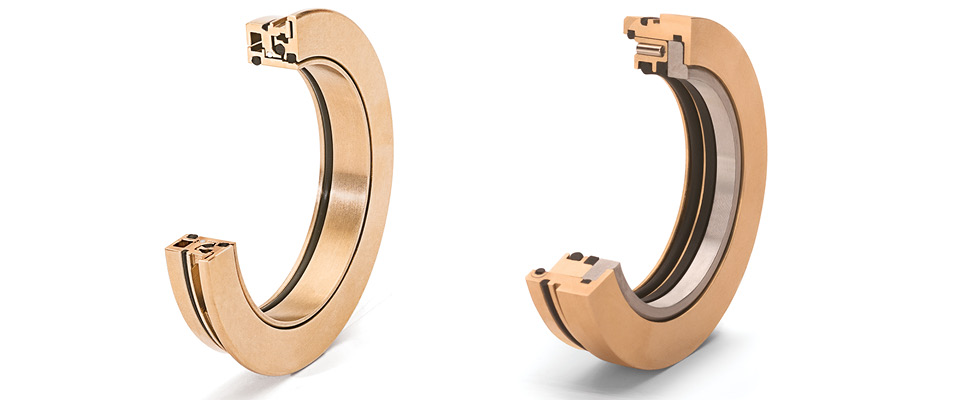
Pumps are routinely placed into severe duty applications where durability and reliability are critical. But even the most expertly designed and stout pieces of equipment can be vulnerable to downtime, or even failure, in these challenging conditions if not maintained properly.
Proper lubrication and protection of the bearings are key factors supporting pump longevity. Without proper lubrication, failure is inevitable and leads to high-cost repairs, replacements and downtime.
While there are many lubrication methods, there is one that has gained popularity and relevance for pumps in downstream applications, such as refining and petrochemical, and that is oil mist. This lubrication method uses an aerosol mixture of fine oil droplets suspended in air. A secondary system takes oil from a supply tank and atomizes it into finer particles. That particulate mixture is then distributed to the bearings.

IMAGE 1: Bearing isolator designed to create an ideal oil mist seal (Images courtesy of Inpro/Seal)
Oil mist has gained traction in downstream applications because it provides precise lubrication, which means less power consumption, less lubrication excess and waste, fresher lubrication coverage on the bearings and better pump mean time between failures (MTBF).
Oil Mist Challenges
While oil mist use continues to grow favorably among pump operators, it presents sealing challenges. The main difficulty associated with oil mist is keeping it contained within the equipment. Because the lubrication particles are very fine, minuscule openings or leak paths can allow the oil mist to escape, impacting bearing life and operator safety. A leading cause of equipment downtime and lost production is bearing failure, and failed bearings occur predominantly due to lubrication loss and contamination. Additionally, stray hydrocarbons can be inhaled or pool on surfaces to create potential fall hazards. Proper sealing selection is important to operator safety and equipment reliability.
The American Petroleum Institute (API) recognizes the benefits and prominence of oil mist, which is why most API pumps are oil mist-lubricated equipment. Meeting the API standard—specifically API 610— means having bearing housings with one of two specific sealing solutions. It states that “bearing housings shall be equipped with replaceable labyrinth-type or magnetic-type end seals and deflectors where the shaft passes through the housing. Lip-type seals shall not be used. The seals and deflectors shall be made of spark-resistant materials.”
Additionally, the U.S. Environmental Protection Agency (EPA) has tightened regulations on emissions and other particulates. While regulation development is ongoing, operators are continually pressed to reduce carbon emissions and eliminate hydrocarbon leakage. As oil mist is an aerosol mixture, it is not always possible to detect leaks with the naked eye. Preventing leakage starts with having the right bearing seal technology in place.
Durable Sealing Protection
Bearing isolators are two-part compound labyrinth or magnetic seals consisting of a rotor and stator working in conjunction to protect rotating equipment from lubrication loss and contamination ingress. However, not all of them are the same. For oil mist, operators must be aware that bearing isolators are engineered to order, utilizing specialized materials, design concepts and features to provide their application the right protection. The technology is not general or plug-and-play with any piece of rotating equipment. In the case of oil mist lubrication, the proper design of the bearing isolator will determine if the equipment is protected. There are several design criteria to consider when selecting a bearing isolator for oil mist applications.
Labyrinth-type bearing isolator: In this type of bearing isolator, operators should make sure there is a coalescing ring that blocks mist from escaping through the labyrinth, where it is collected and deposited back into the bearing housing through the lube return. Another essential component is a vapor-blocking (VBX) ring. Bearing isolators depend on centrifugal force to operate; however, there are times when equipment needs to be shut down. The VBX ring ensures the labyrinth path is shut off and no oil mist can escape while the equipment is at rest. During operation, centrifugal force provides lift so it is still operating with a non-contact design.
The stator/rotor interface is another key piece of internal technology. Properly designed interfaces provide permanent IP66-rated protection against contamination ingress. A contamination chamber should also be a part of the bearing isolator’s design to collect contaminants trying to enter the bearing housing and expel them through the expulsion port using centrifugal force and gravity. Another important design element is the D Groove. As the name suggests, it
is a D-shaped groove built into the rotor that captures oil on the shaft. The oil runs along the groove and is returned to the bearing housing.
Aside from its sealing and protection benefits, labyrinth-type bearing isolators are also known for their longevity. Because they do not depend on contact as a sealing mechanism, this technology can last as long as the equipment.
Magnetic-type bearing isolator: This technology works differently but is still an effective choice for oil mist-lubricated environments. Magnetic-type seals utilize two precision-lapped faces that are magnetically energized to create a liquid-tight seal. The critical element is ensuring the seal is designed so the faces maintain proper lubrication and the face loading is distributed equally around the rotor and tuned specifically for oil mist. Additionally, operators must take extra care while installing magnetic-type seals so the faces are not damaged. Flat faces are critical to maintaining a quality seal. Magnetic-type seals are a great choice for oil mist, as positive contact seals effectively seal fine mist particles.
Both labyrinth- and magnetic-type bearing isolators do not cause shaft wear, a common problem tied to elastomeric lip seals, which can wear quickly at the contact point and damage the shaft.

